Abstract
The relations between 24 hour urinary electrolyte excretion and blood pressure were studied in 10,079 men and women aged 20-59 sampled from 52 centres around the world based on a highly standardised protocol with central training of observers, a central laboratory, and extensive quality control. Relations between electrolyte excretion and blood pressure were studied in individual subjects within each centre and the results of these regression analyses pooled for all 52 centres. Relations between population median electrolyte values and population blood pressure values were also analysed across the 52 centres. Sodium excretion ranged from 0.2 mmol/24 h (Yanomamo Indians, Brazil) to 242 mmol/24 h (north China). In individual subjects (within centres) it was significantly related to blood pressure. Four centres found very low sodium excretion, low blood pressure, and little or no upward slope of blood pressure with age. Across the other 48 centres sodium was significantly related to the slope of blood pressure with age but not to median blood pressure or prevalence of high blood pressure. Potassium excretion was negatively correlated with blood pressure in individual subjects after adjustment for confounding variables. Across centres there was no consistent association. The relation of sodium to potassium ratio to blood pressure followed a pattern similar to that of sodium. Body mass index and heavy alcohol intake had strong, significant independent relations with blood pressure in individual subjects.
Full text
PDF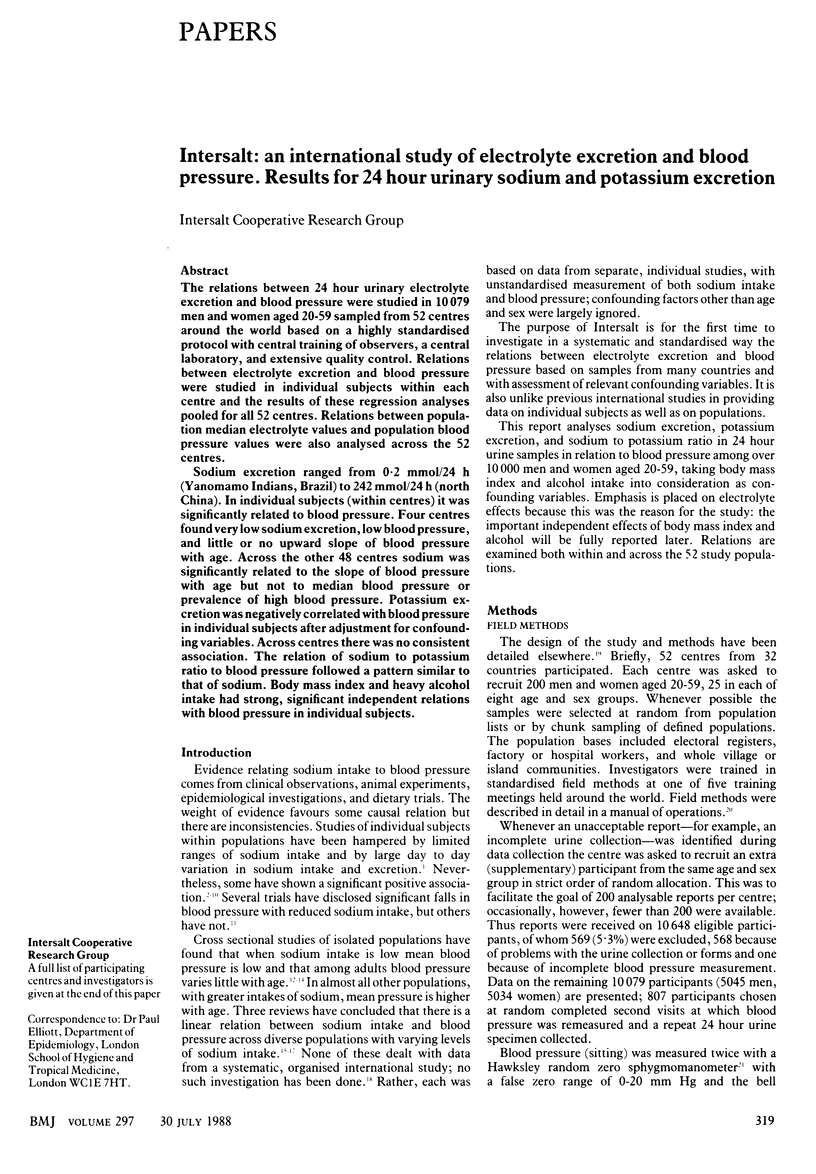
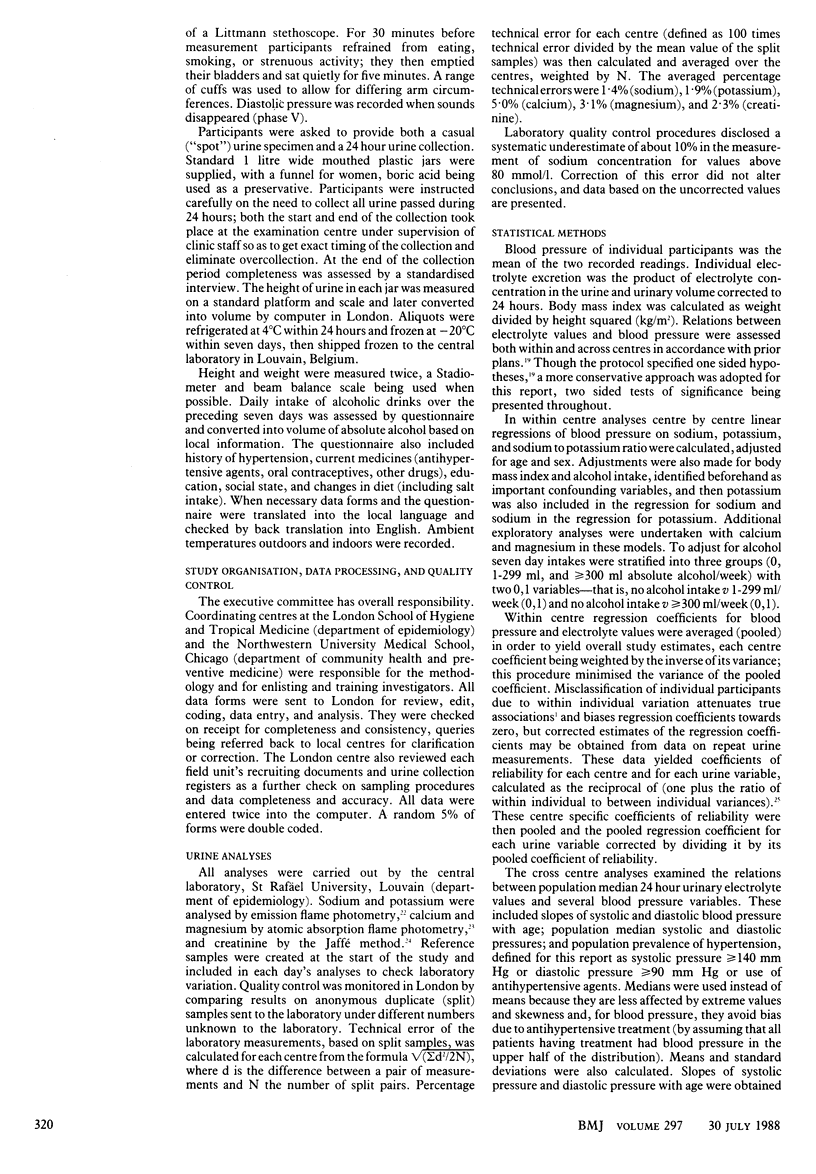



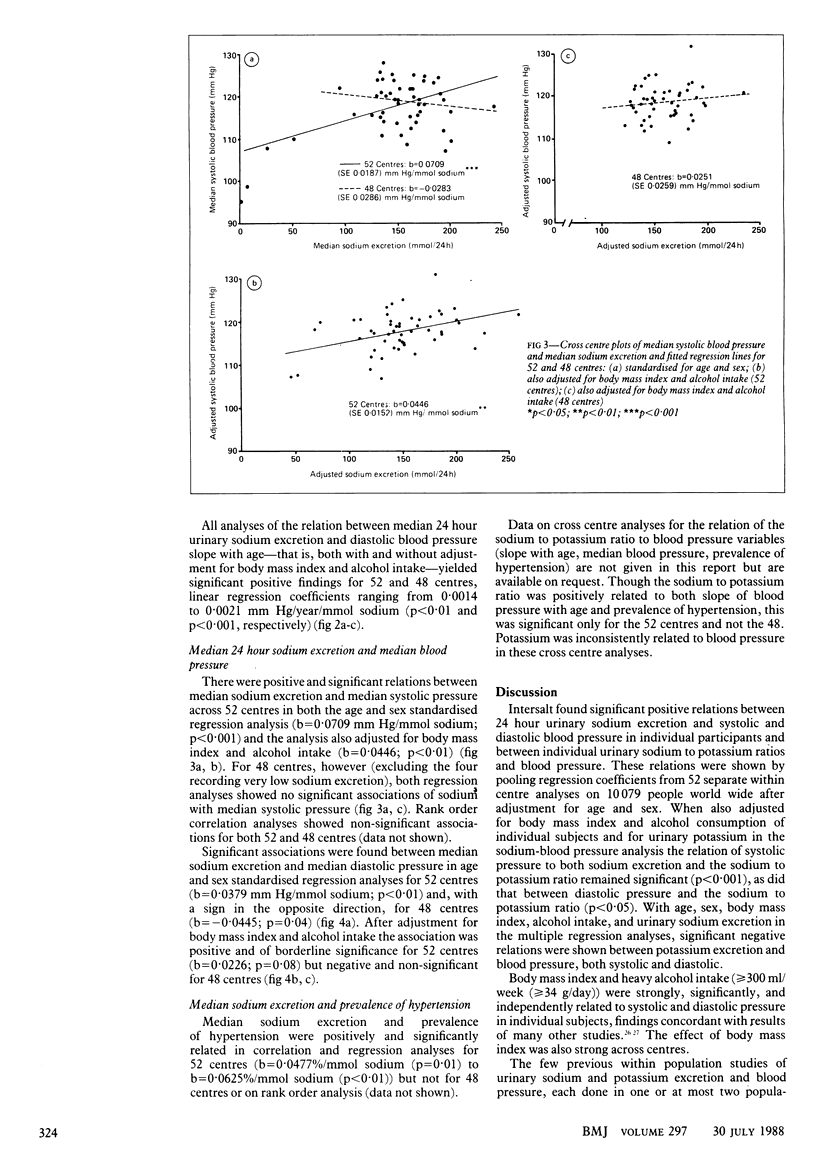
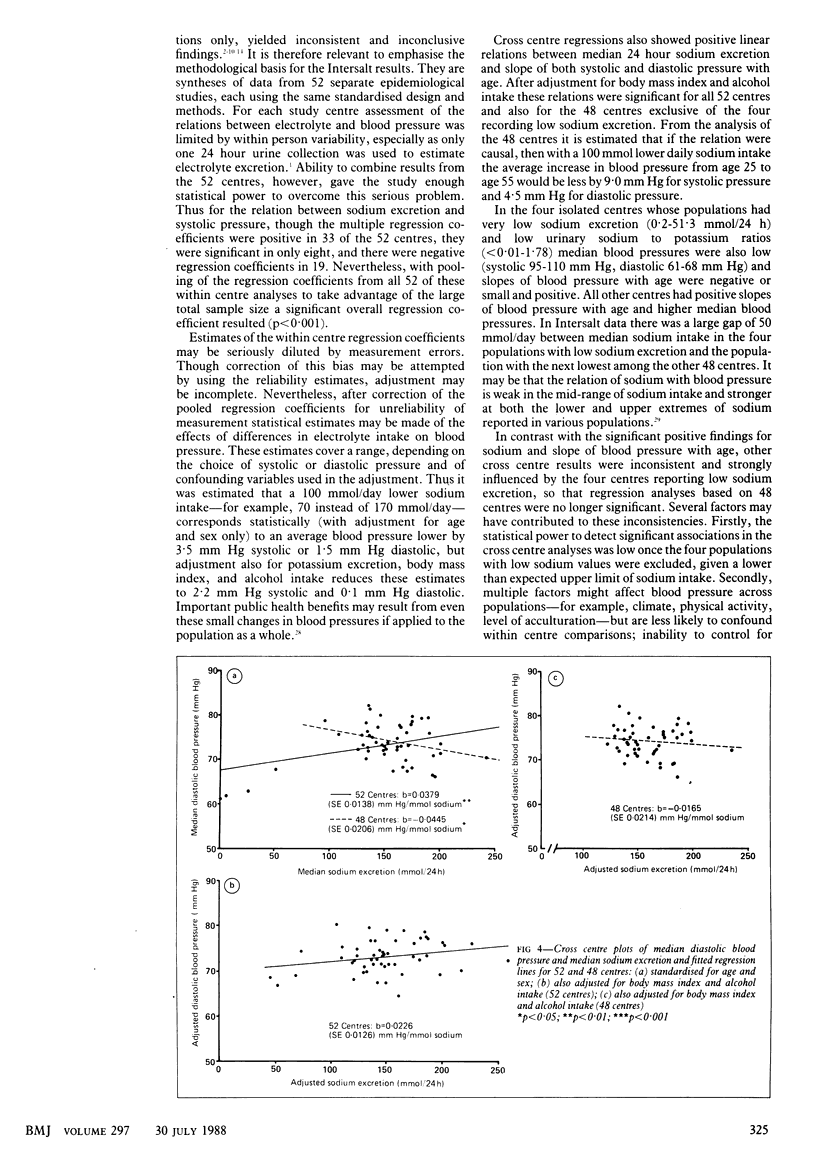


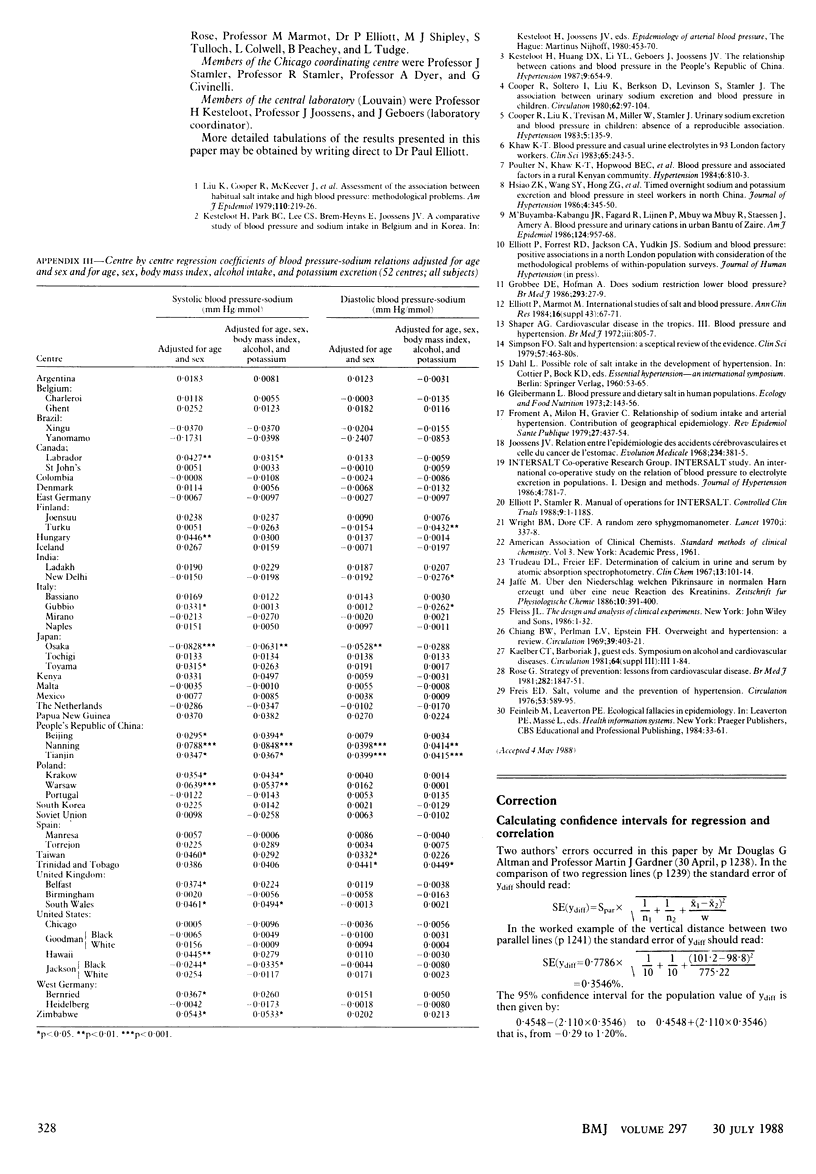
Selected References
These references are in PubMed. This may not be the complete list of references from this article.
- Chiang B. N., Perlman L. V., Epstein F. H. Overweight and hypertension. A review. Circulation. 1969 Mar;39(3):403–421. doi: 10.1161/01.cir.39.3.403. [DOI] [PubMed] [Google Scholar]
- Cooper R., Liu K., Trevisan M., Miller W., Stamler J. Urinary sodium excretion and blood pressure in children: absence of a reproducible association. Hypertension. 1983 Jan-Feb;5(1):135–139. doi: 10.1161/01.hyp.5.1.135. [DOI] [PubMed] [Google Scholar]
- Cooper R., Soltero I., Liu K., Berkson D., Levinson S., Stamler J. The association between urinary sodium excretion and blood pressure in children. Circulation. 1980 Jul;62(1):97–104. doi: 10.1161/01.cir.62.1.97. [DOI] [PubMed] [Google Scholar]
- Elliott P., Marmot M. International studies of salt and blood pressure. Ann Clin Res. 1984;16 (Suppl 43):67–71. [PubMed] [Google Scholar]
- Freis E. D. Salt, volume and the prevention of hypertension. Circulation. 1976 Apr;53(4):589–595. doi: 10.1161/01.cir.53.4.589. [DOI] [PubMed] [Google Scholar]
- Froment A., Milon H., Gravier C. Relation entre consommation sodée et hypertension artérielle. Contribution de l'épidémiologie géographique. Rev Epidemiol Sante Publique. 1979;27(5-6):437–454. [PubMed] [Google Scholar]
- Hsiao Z. K., Wang S. Y., Hong Z. G., Liu K., Cheng T. Y., Stamler J., Tao S. C. Timed overnight sodium and potassium excretion and blood pressure in steel workers in North China. J Hypertens. 1986 Jun;4(3):345–350. doi: 10.1097/00004872-198606000-00014. [DOI] [PubMed] [Google Scholar]
- Kesteloot H., Huang D. X., Li Y. L., Geboers J., Joossens J. V. The relationship between cations and blood pressure in the People's Republic of China. Hypertension. 1987 Jun;9(6):654–659. doi: 10.1161/01.hyp.9.6.654. [DOI] [PubMed] [Google Scholar]
- Khaw K. T. Blood pressure and casual urine electrolytes in 93 London factory workers. Clin Sci (Lond) 1983 Sep;65(3):243–245. doi: 10.1042/cs0650243. [DOI] [PubMed] [Google Scholar]
- M'Buyamba-Kabangu J. R., Fagard R., Lijnen P., Mbuy wa Mbuy R., Staessen J., Amery A. Blood pressure and urinary cations in urban Bantu of Zaire. Am J Epidemiol. 1986 Dec;124(6):957–968. doi: 10.1093/oxfordjournals.aje.a114485. [DOI] [PubMed] [Google Scholar]
- Meinert C. L. Toward prospective registration of clinical trials. Control Clin Trials. 1988 Mar;9(1):1–5. doi: 10.1016/0197-2456(88)90002-5. [DOI] [PubMed] [Google Scholar]
- Poulter N., Khaw K. T., Hopwood B. E., Mugambi M., Peart W. S., Rose G., Sever P. S. Blood pressure and associated factors in a rural Kenyan community. Hypertension. 1984 Nov-Dec;6(6 Pt 1):810–813. doi: 10.1161/01.hyp.6.6.810. [DOI] [PubMed] [Google Scholar]
- Rose G. Strategy of prevention: lessons from cardiovascular disease. Br Med J (Clin Res Ed) 1981 Jun 6;282(6279):1847–1851. doi: 10.1136/bmj.282.6279.1847. [DOI] [PMC free article] [PubMed] [Google Scholar]
- Shaper A. G. Cardiovascular disease in the tropics. 3. Blood pressure and hypertension. Br Med J. 1972 Sep 30;3(5830):805–807. doi: 10.1136/bmj.3.5830.805. [DOI] [PMC free article] [PubMed] [Google Scholar]
- Trudeau D. L., Freier E. F. Determination of calcium in urine and serum by atomic absorption spectrophotometry (AAS). Clin Chem. 1967 Feb;13(2):101–114. [PubMed] [Google Scholar]
- Wright B. M., Dore C. F. A random-zero sphygmomanometer. Lancet. 1970 Feb 14;1(7642):337–338. doi: 10.1016/s0140-6736(70)90709-9. [DOI] [PubMed] [Google Scholar]


